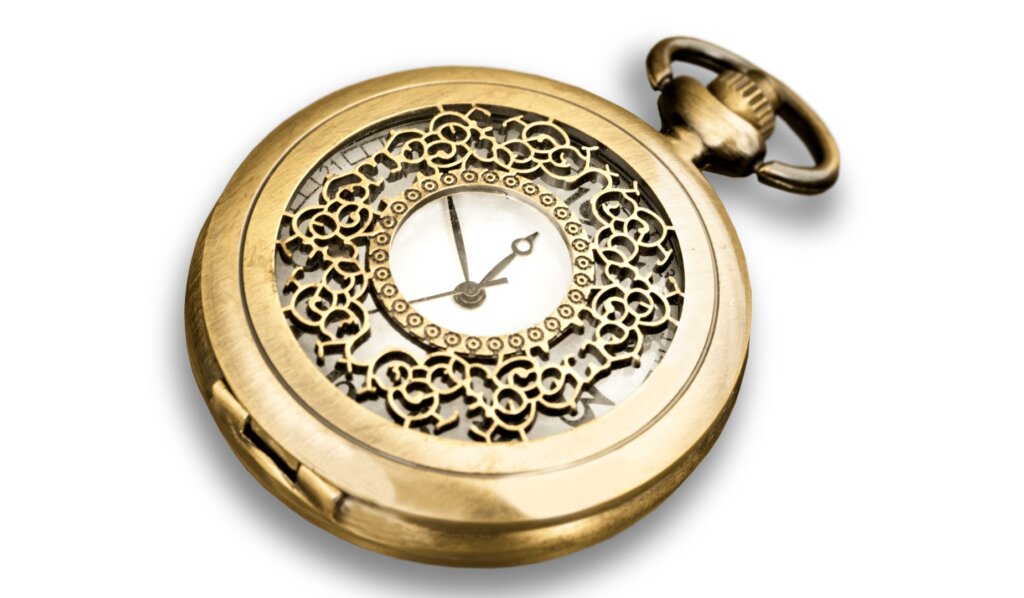You will be able to determine the value of an old pocket watch if you can identify it correctly. You’ll first need to understand the terms used to describe pocket watch parts, and then the most sought-after brands. You can start by following some simple tips to identify and value your old pocket watches, then consult a professional if necessary.
Identification of the serial number
The case of an American-made pocket watch may have one type of marking and another on the “movement” or inner workings because each component was usually made by a separate company. The serial number is usually engraved on the movement of a pocket watch. You can find it by carefully opening the back cover. You can then search the Pocket Watch Database or the tables provided by pocket watches by their dial or case.
- Demi-hunter Case: The cover features a small window that allows you to tell the time even without opening it. This style is mainly European.
- Hunter case: A type of watch with a metal round cover that is attached to a spring-hinged hinge. The cover closes to protect the crystal on the dial. The winding mechanism or stem will be at the third position of the watch.
- Pocket watches for military use: These watches were issued to the military in certain regions until the early 1900s. They were simple and standard.
- This type of watch has no cover that protects the glass or crystal on the dial. The crown and winding stem will be at the 12th position of the watch.
- This pair-cased pocket watch was made in the middle of the 18th century. It is an open-faced pocket watch set inside a hunting case. The inner case is removed to wind the pocket watch and then placed into the outer case as protection.
- Railroad pocket watches: Railroad pocket watches are made and used by railroad workers. Open-faced watches made after 1908 tend to be the most common.
- Watches made of stainless steel: These pocket watches have a stainless steel case.
- Conversion of a wristwatch into a pocket watch
Watch Movements Identification
Movements are the machine parts of a pocket watch that work. Pocket watches have different movement types that can wind and set them in different ways.
- You will need a key to wind the watch and set it. From the 1600s to the mid-1800s, this was the standard.
- Stem-wind and stem-set: This type was first introduced in 1850. It eliminates the use of a key by using a stem.
- This type of watch is set by opening the dial to gain access to the special setting lever. In the early 1900s, railroad watches were often set this way.
- Pin-set, stem-wind: This modern movement requires you to press the pin and then turn it to set the time, before releasing it.
- Jewelled: High-end watches have used this type of movement for centuries to reduce friction.
Popular Antique Pocket Watch Brands
Many collectors collect popular brands, even though they may have specific criteria. All pieces would have the brand’s name or logo.
- Ebel is a Swiss company that was founded in 1911, and it’s known for its high-end and beautiful designs. In 2020, a yellow-gold Ebel pocket watch was sold on eBay for approximately $2100.
- Elgin was founded in 1864 and originally known as the National Watch Company. It is an American watch manufacturer that produces mid-quality timepieces. Elgin watches in 14K gold have sold for more than $2,000 each.
- Longines is another Swiss watchmaker founded in 1832. All of their watches have a winged-hourglass logo on the movement, with the company’s name on the dial. Old Longines can be purchased for between $500 and $5,000.
- Waltham: The Waltham Watch Company was founded in 1850. They were the first to mass-produce watches. Antique Waltham can be found for between $150 and $500.
Antique Pocket Watch Valuation Tips
Many old pocket watches are less than $200 and have no real value, as they are not in good condition or do not work. The most expensive pocket watch ever sold was worth 24 million dollars. The antique Patek Philippe sold in 2014 by Sotheby’s was valued at $250,000. It had appeared on Antiques Roadshow. This is an exception.

Factors that affect the value of a pocket watch
The brand name and the condition of an antique pocket clock are the two most important factors that determine its value. You can either consult a watch expert to get an idea of what a pocketwatch is worth or become one yourself.
- Brand name: Like many antiques, pocket watches with manufacturers known for their quality or by name will be valued more as demand is higher. Swiss-made watches are the most valuable and popular.
- Condition: A watch in good working order is worth more than one that does not work. Holding the watch up to your ear, listen for a “ting ting ting” sound.
- You can determine rarity by finding out how many watches of a particular model were produced. The rarer it is, the more valuable it will be.
- Jewel count: The rubies in the watch mechanism have no real value but reduce friction. The more jewels, the higher the value of the watch.
- The movement of a higher-quality pocket watch will include more fine details, such as embellished plates and gold jewel settings.
- Material of the watch case: Stainless steel is very common and affordable, but solid gold cases have a higher value due to their gold content.
Indicators of high-value
You should consult an expert if you notice any of these signs on your pocket watch. It could be worth a lot.
- Extensive case: Cases with enamel, gold, or precious stones, as well as those that are painted, are more expensive than plain ones.
- Gold Case: gold cases marked 14, 18K, or 750 on the inside of the back cover are more valuable than watches without markings. It is not gold if there is no stamp.
- Weight: A heavy pocket watch could indicate a highly sophisticated movement, or that the case is solid gold. A heavy pocket watch should be thoroughly investigated.
Pocket Watches Buying and Selling Tips
You’ll get the highest price when you sell pocket watches in sets. Stephen Bogoff, an American expert on antique pocket watches, has been involved in the auction industry since 1970. He is one of the few trustworthy online sources that you can use to learn about the market and view different styles. Barnebys is relatively new in Europe but is an established global auction site that specializes in watches, antiques, and fine arts.
Pocket Watches: A Brief History
Alan Costa, of the National Association of Watch & Clock Collectors, has written a treatise about the history of watches. He states that the first personal timekeeping device was not invented until 1600, when the hairspring (also known as a balancespring) was developed. Peter Henlein was a locksmith who made the first pocket clock in 1524. It was worn as a necklace. Watches of the 1600s were more jewellery than accurate timekeepers.
European Pocket Watch Innovations
In 1675, the first pocket-sized watch was introduced. was set by King Charles II in England, who spread the style across Europe and North America. The lever escapement was introduced in 1750. The clockmaker could now add a minute dial to the watch, which wasn’t present in earlier models.
Pocket Watches In America
The American Watch Company, in Waltham (Massachusetts), later known as Waltham Company, was the first American company to produce a pocket watch. Around 1850, watchmakers like Hamilton, Elgin and Illinois in America, and Alange-Soehne, in Europe, began to produce more watches.
It’s Time to Learn About Pocket Watches
To identify and determine the value of a pocket watch, you must first learn about its history. Many old pocket watches may not be worth much in money terms, but they are great collectors’ pieces that have sentimental value to historians and families.


